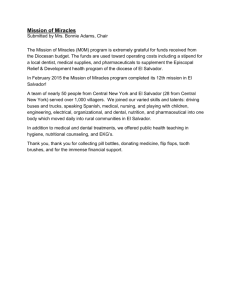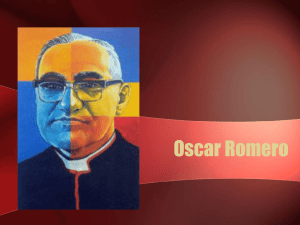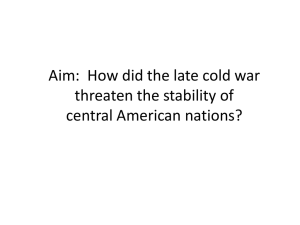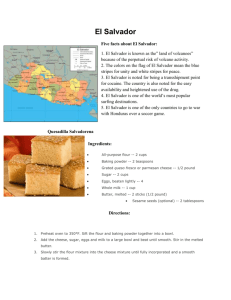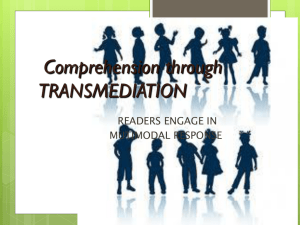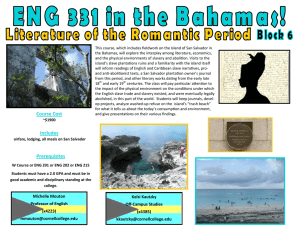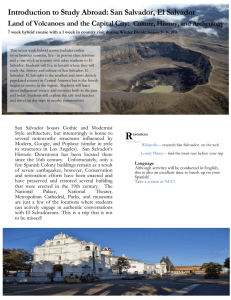Comparing San Salva- 2 dor & Managua Celebrating the Life of
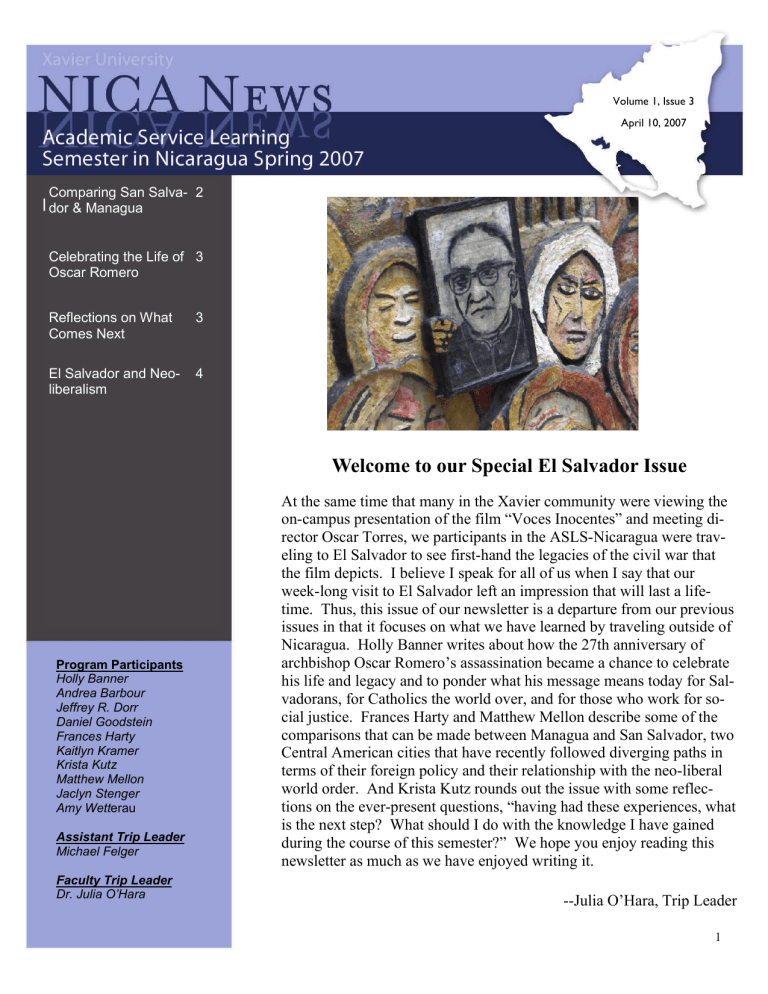
Volume 1, Issue 3
April 10, 2007
Comparing San Salvador & Managua
2
Celebrating the Life of
Oscar Romero
3
Reflections on What
Comes Next
3
El Salvador and Neoliberalism
4
Program Participants
Holly Banner
Andrea Barbour
Jeffrey R. Dorr
Daniel Goodstein
Frances Harty
Kaitlyn Kramer
Krista Kutz
Matthew Mellon
Jaclyn Stenger
Amy Wett erau
Assistant Trip Leader
Michael Felger
Faculty Trip Leader
Dr. Julia O’Hara
Welcome to our Special El Salvador Issue
At the same time that many in the Xavier community were viewing the on-campus presentation of the film “Voces Inocentes” and meeting director Oscar Torres, we participants in the ASLS-Nicaragua were traveling to El Salvador to see first-hand the legacies of the civil war that the film depicts. I believe I speak for all of us when I say that our week-long visit to El Salvador left an impression that will last a lifetime. Thus, this issue of our newsletter is a departure from our previous issues in that it focuses on what we have learned by traveling outside of
Nicaragua. Holly Banner writes about how the 27th anniversary of archbishop Oscar Romero’s assassination became a chance to celebrate his life and legacy and to ponder what his message means today for Salvadorans, for Catholics the world over, and for those who work for social justice. Frances Harty and Matthew Mellon describe some of the comparisons that can be made between Managua and San Salvador, two
Central American cities that have recently followed diverging paths in terms of their foreign policy and their relationship with the neo-liberal world order. And Krista Kutz rounds out the issue with some reflections on the ever-present questions, “having had these experiences, what is the next step? What should I do with the knowledge I have gained during the course of this semester?” We hope you enjoy reading this newsletter as much as we have enjoyed writing it.
--Julia O’Hara, Trip Leader
1
Comparing San Salvador and Managua
Romero anniversary marchers in downtown San Salvador file past an enormous KFC.
Nicaragua Bloopers!
Here are the answers you were waiting for—
1. Told his/her family that s/he prefers omelettes made with ojos (eyes).
•
Amy Wetterau
2. Face-planted in the mud while trying to dislodge the minibus.
•
Daniel Goodstein
3. Accidentally dyed all of his/her laundry pink.
•
Dr. Julia O’Hara
4. Missed the bus stop and had to hike
20 minutes uphill to get home.
•
Holly Banner and Krista Kutz
5. Told host father “Soy el baño!” (translation: “I am the bathroom,” not “I am in the bathroom.”)
•
Andrea Barbour
6. Made tons of Nica friends despite knowing only two phrases in Spanish.
•
Dr. John Fairfield
Within the first few minutes of arriving in San Salvador, I could tell some stark differences from Managua. Even looking out the window before getting off the bus to San
Salvador, I could see the bigger buildings, smoother roads with clearly marked street signs, and more uniform transportation (taxis and buses). Also noticeable was the difference in geography. Located in a valley, there are many buildings built into the hillsides. While we only saw a relatively small part of the city and it was for only a few days, it was clear that not all capital cities in Central America are the same. As we saw more of the city I noticed more and more influences from US culture. Whether it is a result of the large number of immigrants transferring the culture back to their homeland or the rapidly growing process of globalization, it was obvious in everything from the wider usage of English to the streets lined with US fast food restaurants and malls filled with multinational companies. This just served to remind us how widespread the influence of globalization is becoming and how greatly our culture is affecting others. And while Managua is also becoming more influenced by the US, there is certainly a greater amount in San Salvador. While there are many differences and what some may consider advancements by
US standards, the reality is that El Salvador is still suffering as a country of the global south. The poor still struggle in oppression by the rich and the government as was made obvious by the stories we heard in La Cuchilla and in seeing some parts of the city. In closing, we can say that there is a lot to process as a result of our trip and many questions we will seek answers to while in Central America.
—By Frances Harty
This just served to remind us how widespread the influence of globalization is becoming and how greatly our culture is affecting others.
Jeff Dorr reflects at the monument to the dead and disappeared in El Salvador’s civil war.
Five Magic Phrases
Mastering these phrases is the first step to talking like a true
Nicaraguan.
¡Buenas!
A friendly greeting for any occasion.
Mucho gusto.
Nice to meet you.
¡Que tuani!
How cool!
Entonces…
So…
Con permiso.
Excuse me.
2
Celebrating the Life of Oscar Romero
When visiting El Salvador it is hard to miss the overwhelming affection of the people for Oscar Romero. It is especially difficult when visiting during the anniversary of his assassination. Monseñor Romero has been a central character in the struggle of the poor and oppressed not only in El Salvador but all over Central
America and even the world. His importance in the struggle for the people is constantly demonstrated through el pueblo (the people).
As a group, we had to opportunity to visit Divina Providencia, the location where Monseñor Romero lived as well as where he was assassinated on March 24, 1980. Many emotions flowed through the group as we looked upon the place where Monseñor Romero spoke his final words. As we sat in the church, a nun came to us and began to talk about the history of Monseñor Romero. She told us about his mission for the poor and how he made the ultimate sacrifice of his life for the people. He had been receiving threats on his life but refused to give in, knowing that his work toward the liberation of his people was more important than anything else.
On Saturday, March 24, we attended a march that was held for Romero in San Salvador. Tens of thousands were in attendance for this magnificent event. We marched slowly for a couple of hours to
Reflections on What Comes Next
the Cathedral in San Salvador. People carried signs, chanted, sang, and held candles in memory of Monseñor Romero and his work. It was a powerful sight to see the impact of one man in history. He became such an important martyr, his words and insights will live on until liberation for all becomes a reality. The next day the group attended mass in the Crypt of Monseñor
Romero, where once again we were able to see the impact of Romero’s life. During the homily, the priest spoke of freedom for the people in all aspects of life, mirroring the ideals of Monseñor Romero. It was a very compelling learning experience to see and feel the power of the words and actions of Monseñor Romero.
—By Holly Banner
People carried signs, chanted, sang, and held candles in memory of
Monseñor Romero and his work. It was a powerful sight to see the impact of one man in history.
Bus fare to and from our service sites: 5 córdobas ($.28)
Lunch at Comedor Coco´s: 36 córdobas ($2)
New pavement at Olla de la Soya : 2646 córdobas ($147)*
The opportunity grapple with difficult issues and ask challenging questions: PRICELESS
The priceless experiences at home and in our travels have left us stumped. It is clear, after hours of reflection and discussion, that all of us— students and leaders—are grappling with the same question: What am I going to do with all I have learned once I return to the United
States?
Our classes, trips, and service-work have brought many issues to the table for us to consider. Studies of the recent civil wars of Nicaragua and
El Salvador, particularly the United States´ involvement in them, have made us think critically about our country´s foreign policy. Readings about Central American maquiladoras , or sweat shops, have challenged us to rethink where we spend our money. Living in communities where we must conserve electricity and water makes us cognizant of how much energy we consume back home. In Nicaragua, we are not just learning academic material to pass our classes. Rather, we are learning so that we can reevaluate the role we play in the global society. What changes should we make in our personal lives? How do we raise awareness of the issues at Xavier? As citizens of the United
States, how do we effect change where changes must be made? Our experiences are posing the questions, and we have yet to find the answers...
-By Krista Kutz
*Funded by donations received at the send-off Mass at Bellermine Chapel!
3
Sidewalk graffiti protests CAFTA and El
Salvador’s controversial new antiterrorism law.
El Salvador and Neoliberalism
El Salvador is a country plagued by a turbulent and violent history.
Coming out of the civil war, in
1992 the Peace Accords offered new hope for the war-torn country.
The government set about improving the economy utilizing freemarket initiatives such the privatization of the banking system, telecommunications, public pensions, electrical distribution, and some generation of electricity as well. A reduction of import duties also was initiated to spur international trade. A solid growth of GDP since the 90´s has been a result of these initiatives. Yet the population of El Salvador suffers from a severe inequality in the distribution of wealth. Many of the jobs provided to the poor are in maquiladoras (factories) owned by transnational companies that frequently do not provide sufficient income for their employees. The capital city, San Salvador, with its multistoried buildings, manicured lawns and shopping centers, gives an impression that the country has a large middle- and upper-class population and as a whole is doing well. As it turns out, the city is where the concentration of the country’s wealthy families reside. Yet one only has to observe farther into the mountainous country to see the poverty that afflicts the rest of the nation.
—By Matthew Mellon
Academic Service Learning
Semester in Nicaragua
Dr. Julia O’Hara ohara@xavier.edu
For more information on Xavier’s
Academic Service Learning Semesters in Nicaragua, Ghana, India and Urban
Cincinnati, contact:
Dr. Irene B. Hodgson,
Interim Director
513-745-3541 hodgson@xavier.edu http://www.xu.edu/ service_learning/
4
